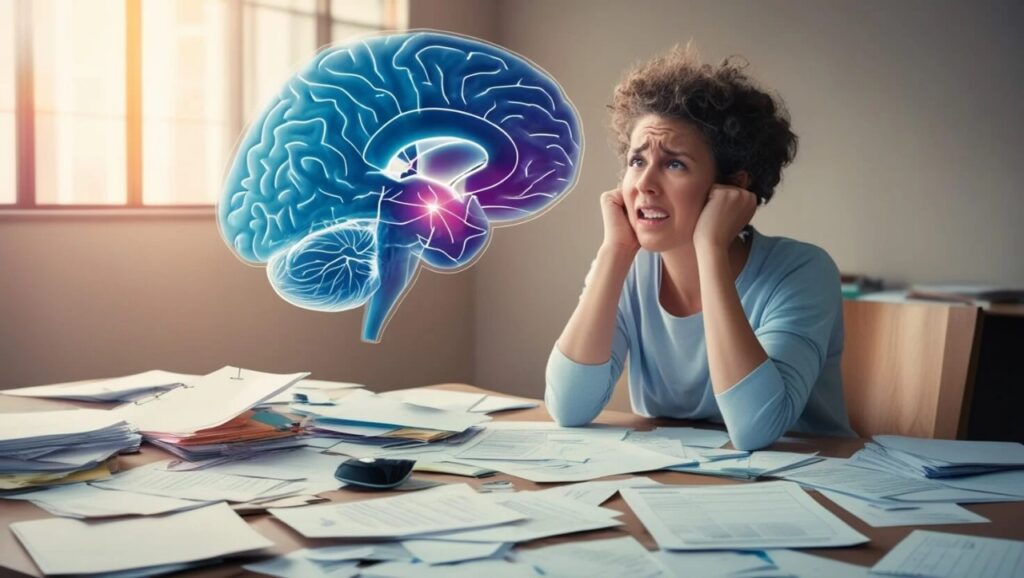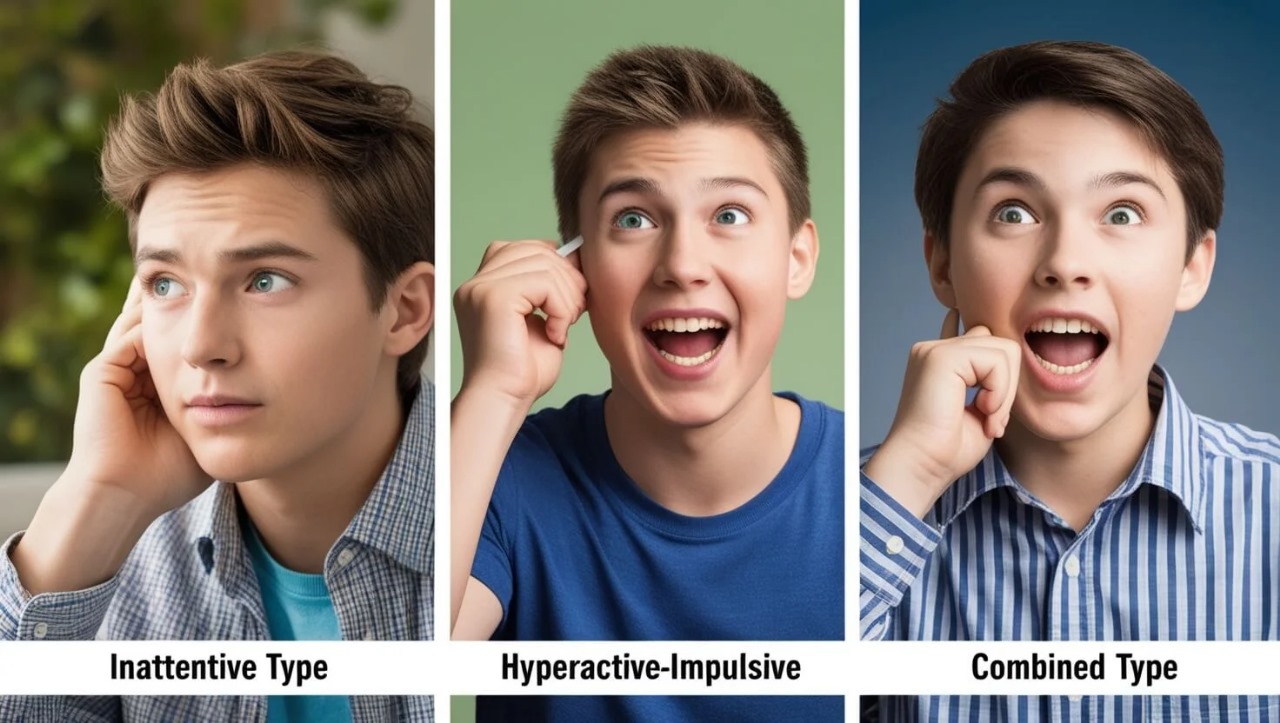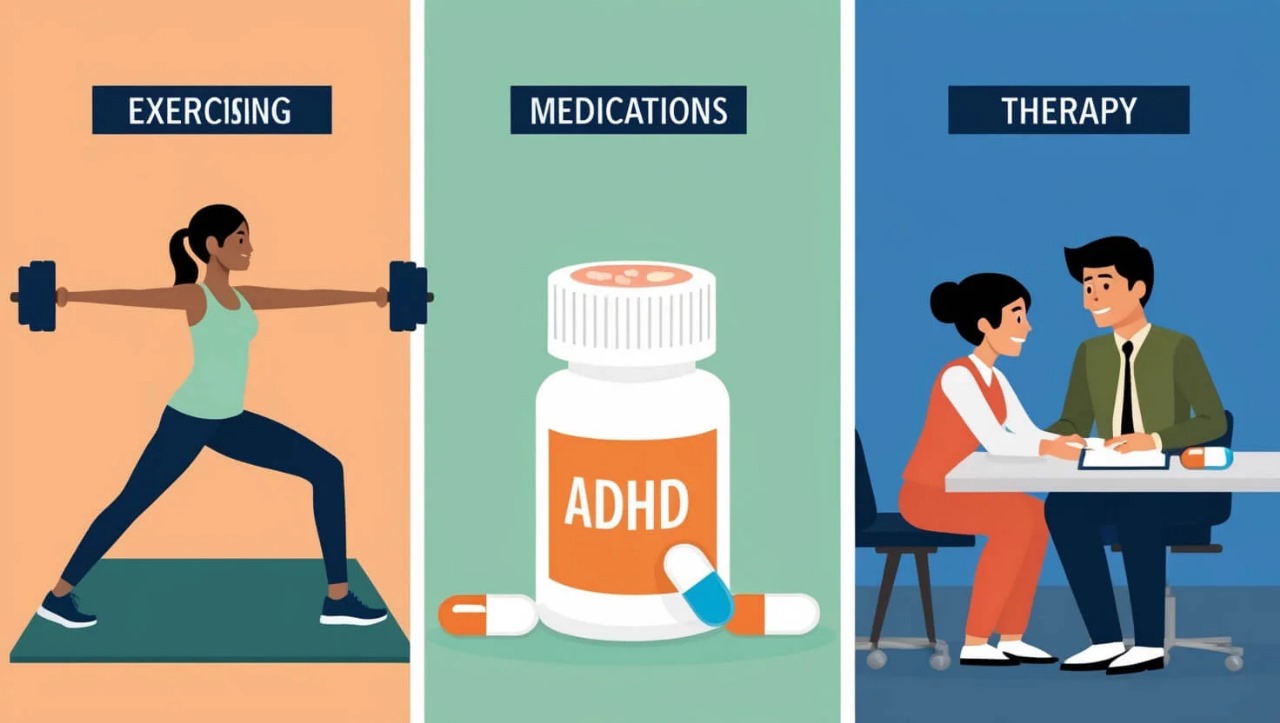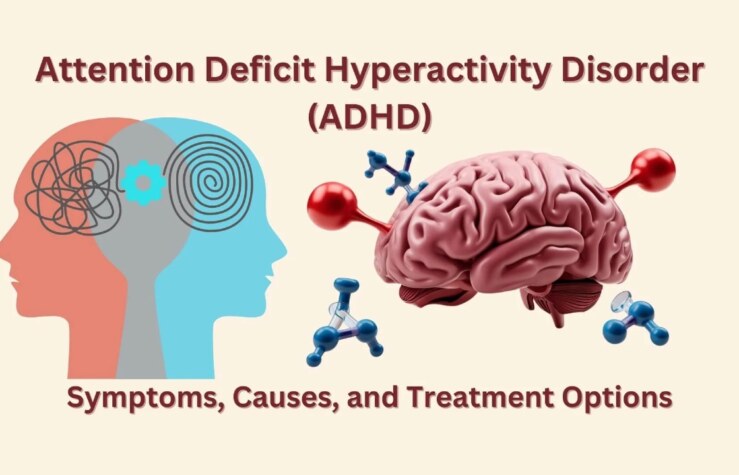Attention Deficit Hyperactivity Disorder is one of the most prevalent neuro developmental disorders that affect both children and adults. With increasing awareness about mental health, ADHD has gained significant attention, yet many misconceptions and myths surround it. This article aims to offer an in-depth understanding of ADHD, focusing on its symptoms, causes, diagnosis, and treatment options.
What is ADHD?

Attention Deficit Hyperactivity Disorder, is a condition characterized by a persistent pattern of inattention, hyperactivity, and impulsivity. These symptoms interfere with daily functioning and development. ADHD typically manifests in childhood, with symptoms that can persist into adulthood. It affects not only the individual’s ability to focus and regulate impulses but also impacts academic performance, workplace productivity, and social interactions.
Types of ADHD
It is a multifaceted neurodevelopmental disorder that affects millions of people globally, from childhood through adulthood. It is not a one-size-fits-all condition; it manifests in different ways depending on the individual. Recognizing this, the medical community has categorized ADHD into three primary types: Inattentive Type, Hyperactive-Impulsive Type, and Combined Type. Each of these types has its own unique set of symptoms and challenges. Comprehending these distinctions is essential for precise diagnosis and efficacious therapy.

Inattentive Type (Formerly Known as ADD)
The inattentive type of ADHD, often referred to as “ADD” (Attention Deficit Disorder), is characterized by a significant difficulty in sustaining attention and focus. Unlike other types of ADHD, individuals with this form typically do not exhibit hyperactivity. Instead, they may appear dreamy, sluggish, or easily distracted. This type of ADHD is often underdiagnosed, particularly in girls and adults, as its symptoms are less outwardly disruptive.
Common Symptoms
Individuals with the inattentive type of ADHD may display the following symptoms:
- Difficulty maintaining focus: They may struggle to stay on task, often losing track of assignments or details.
- Careless mistakes: They frequently make errors in schoolwork, work, or other activities that require sustained attention.
- Easily distracted: External stimuli, such as background noise or unrelated thoughts, easily disrupt their concentration.
- Forgetfulness: They often forget tasks or daily responsibilities, such as paying bills or completing homework.
- Poor organizational skills: They may have difficulty organizing their time, materials, or tasks, leading to unfinished projects.
- Difficulty following instructions: Even when spoken to directly, individuals may seem to zone out, making it hard to follow detailed directions.
- Avoiding tasks that require prolonged mental effort: Tasks such as reading, studying, or writing are often avoided or completed hastily.
- Appearing not to listen: Despite no visible distractions, they may seem like they aren’t paying attention in conversations or when given instructions.
Impact
The inattentive type of ADHD can significantly affect academic or workplace performance. People with this form of ADHD may be labeled as lazy or unmotivated, even though their struggles are related to brain function, not effort. The lack of hyperactivity also means this type of ADHD is more likely to go undiagnosed, especially in quieter or more introverted individuals.
Hyperactive-Impulsive Type
The hyperactive-impulsive type of it is marked by excessive energy and impulsivity. Unlike the inattentive type, people with this form of ADHD struggle with sitting still, waiting their turn, and controlling their impulses. These individuals may talk excessively, interrupt others, or make hasty decisions without considering the consequences. This type is often more noticeable in children, as they may disrupt classrooms or social situations.
Common Symptoms
Individuals with hyperactive-impulsive ADHD typically exhibit the following behaviors:
- Fidgeting and restlessness: They may constantly tap their hands or feet, squirm in their seat, or get up frequently when sitting is expected (e.g., in class or during meetings).
- Inability to stay seated: In environments where sitting is required, such as school or work, they may struggle to remain seated for long periods.
- Excessive talking: They may talk excessively, often speaking out of turn or interrupting conversations without realizing it.
- Interrupting others: Impulsivity can lead to frequent interruptions during conversations, games, or activities.
- Difficulty waiting for turns: In settings like games or group discussions, they may have a hard time waiting for their turn.
- Impulsive behavior: This includes making quick decisions without thinking through potential risks or consequences.
- Acting as if “driven by a motor”: People with this form of ADHD often feel the need to be constantly active or engaged in movement.
- Blurting out answers: In educational or social settings, they may shout out answers or comments before questions are finished being asked.
Impact
Hyperactive-impulsive ADHD is often more recognizable in children, especially in structured environments like classrooms. The visible nature of these behaviors can result in disciplinary actions, social isolation, or struggles with authority figures. In adults, hyperactive-impulsive symptoms may appear as restlessness, difficulty remaining calm in social or professional settings, or engaging in risky behaviors.
Combined Type (Most Common)
The combined type of ADHD is the most common form of the disorder, characterized by a mixture of both inattentive and hyperactive-impulsive symptoms. Individuals with this type experience difficulties in maintaining focus and attention, while also struggling with impulse control and hyperactivity. The presence of both sets of symptoms makes this form of ADHD more easily recognizable and disruptive in multiple settings.
Common Symptoms
People with the combined type of ADHD display behaviors from both the inattentive and hyperactive-impulsive categories. Common symptoms include:
- Inattention symptoms: Trouble focusing, disorganization, forgetfulness, and avoidance of tasks that require sustained effort.
- Hyperactivity symptoms: Restlessness, constant movement, excessive talking, and difficulty sitting still.
- Impulsivity symptoms: Interrupting others, acting without thinking, and making hasty decisions.
Impact
The combined type of ADHD often has a significant impact on daily functioning, including academic performance, social interactions, and family dynamics. The combination of inattention and hyperactivity can lead to issues with task completion, maintaining friendships, and meeting expectations in structured environments. Individuals with this type may struggle more visibly in school or work environments due to the wide range of symptoms that affect both attention and behavior.
Causes of ADHD
It is a complex disorder with no single known cause. However, research points to several factors that may contribute to the development of the condition:
- Genetic Factors
- ADHD tends to run in families. Studies have shown that if a parent has this disorder, there’s a higher likelihood their child may also develop the condition.
- Specific genes associated with the regulation of neurotransmitters (such as dopamine) have been linked to it
- Brain Structure and Function
- Imaging studies have identified differences in brain development in individuals with ADHD. Specifically, the frontal lobe, which is responsible for attention, problem-solving, and impulse control, tends to be smaller or less active in people with ADHD.
- Imbalances in neurotransmitters, particularly dopamine and norepinephrine, are also associated with ADHD symptoms.
- Environmental Factors
- Exposure to certain environmental toxins, such as lead, during childhood has been linked to it.
- Maternal drug use, alcohol use, or smoking during pregnancy may increase the risk of ADHD in the child.
- Premature Birth
- Children born prematurely or with low birth weight are at a higher risk of developing ADHD.
Myths and Misconceptions About ADHD
Despite growing awareness, there are still many myths surrounding it. Addressing these misconceptions is crucial for ensuring that individuals with ADHD receive appropriate support and treatment.
- Myth 1: It is not a real disorder.
- Fact: It is recognized by major medical organizations, including the American Psychiatric Association and the World Health Organization, as a legitimate neurodevelopmental disorder.
- Myth 2: It is caused by poor parenting or too much screen time.
- Fact: While environmental factors may exacerbate symptoms, ADHD is primarily a neurological and genetic condition. It is not caused by poor parenting or excessive technology use.
- Myth 3: It only affects children.
- Fact: While it often begins in childhood, it can persist into adulthood, with many adults continuing to experience symptoms of inattention, impulsivity, and restlessness.
Diagnosis of ADHD
Diagnosing it can be challenging because its symptoms overlap with other disorders, such as anxiety, depression, and learning disabilities. A thorough assessment is crucial for accurate diagnosis and treatment.
Diagnostic Criteria
The diagnosis of ADHD is based on the DSM-5 criteria, which require that:
- It is required that the symptoms have existed for a minimum of six months.
- Symptoms should be more severe than what is typical for a person’s developmental stage.
- They must significantly interfere with social, academic, or occupational functioning.
- Symptoms should appear in two or more settings (e.g., home and school).
Diagnostic Process
- Medical and Family History: A healthcare provider will review the patient’s medical history and family background to check for hereditary links or other medical conditions that may explain the symptoms.
- Behavioral Assessments: This involves input from teachers, parents, or colleagues. Structured questionnaires, rating scales, and interviews may be used to assess the frequency and severity of symptoms.
- Psychological Testing: Cognitive tests and learning assessments may be employed to rule out other conditions that mimic its symptoms, such as learning disabilities.
Treatment Options for ADHD
Its treatment usually involves a combination of behavioral therapies, lifestyle changes, and medications. Every person’s treatment approach is customized to meet their unique needs and symptoms.

- Medications
- Stimulants: The most common type of medication used to treat ADHD, stimulants like methylphenidate (Ritalin) and amphetamines (Adderall) increase dopamine levels in the brain, which helps improve attention and focus.
- Non-Stimulants: For individuals who cannot tolerate stimulants, medications like atomoxetine (Strattera) or guanfacine may be prescribed.
- Side Effects: Common side effects of its medications include insomnia, appetite suppression, and mood swings.
- Behavioral Therapy
- Behavioral therapy focuses on modifying negative behaviors associated with ADHD, such as disorganization and impulsiveness. It involves developing strategies for better time management, organizational skills, and emotional regulation.
- Lifestyle Changes
- Regular Exercise: Physical activity can help manage symptoms of it by improving focus, reducing hyperactivity, and relieving stress.
- Healthy Diet: While no specific diet cures ADHD, a balanced diet rich in omega-3 fatty acids, protein, and whole grains may support brain health and improve focus.
- Sleep Hygiene: Ensuring adequate, quality sleep is vital for managing ADHD symptoms.
- Support Systems
- Parental Training: For children with it, training programs can help parents learn how to create structured environments and use positive reinforcement techniques to manage behavior.
- Support Groups: Joining ADHD support groups can be beneficial for both children and adults, providing them with a sense of community and shared experiences.
Conclusion
ADHD is a multifaceted disorder that impacts millions of people globally. While it poses challenges, it is a manageable disorder when properly diagnosed and treated. With the right combination of medication, therapy, and lifestyle changes, people with it can lead successful and fulfilling lives.
Understanding ADHD requires dispelling myths, staying informed, and offering support to those affected. By raising awareness and embracing the nuances of this disorder, we can foster a more inclusive and understanding society. If you or a loved one is experiencing symptoms of ADHD, consult a healthcare provider for a thorough assessment and personalized treatment plan.

